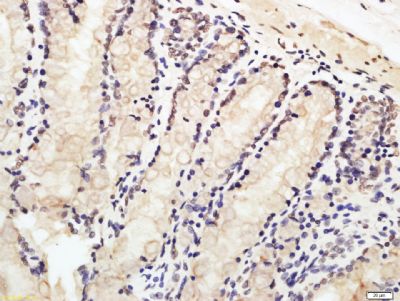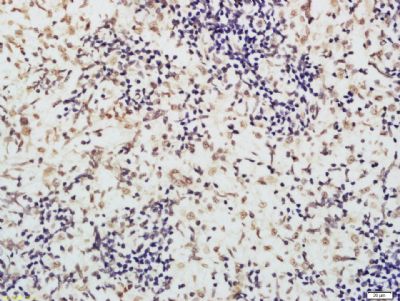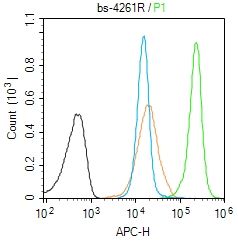产品中心
当前位置:首页>产品中心Anti-XRCC3
货号: bs-4261R 基本售价: 1380.0 元 规格: 100ul
- 规格:100ul
- 价格:1380.00元
- 规格:200ul
- 价格:2200.00元
产品信息
- 产品编号
- bs-4261R
- 英文名称
- XRCC3
- 中文名称
- X射线修复交叉互补蛋白3抗体
- 别 名
- DNA repair protein XRCC3; RAD51 like; X ray repair complementing defective repair in Chinese hamster; X ray repair complementing defective repair in Chinese hamster cells 3; X ray repair cross complementing protein 3; X-ray repair cross-complementing protein 3; XRCC 3; XRCC3; XRCC3_HUMAN.
- 规格价格
- 100ul/1380元购买 200ul/2200元购买 大包装/询价
- 说 明 书
- 100ul 200ul
- 研究领域
- 肿瘤 免疫学 染色质和核信号 信号转导
- 抗体来源
- Rabbit
- 克隆类型
- Polyclonal
- 交叉反应
- Human, Mouse, Rat, Dog, Cow, Rabbit, Sheep,
- 产品应用
- ELISA=1:500-1000 IHC-P=1:400-800 IHC-F=1:400-800 Flow-Cyt=1ug/Test IF=1:100-500 (石蜡切片需做抗原修复)
not yet tested in other applications.
optimal dilutions/concentrations should be determined by the end user.
- 分 子 量
- 38kDa
- 细胞定位
- 细胞核 细胞浆
- 性 状
- Lyophilized or Liquid
- 浓 度
- 1mg/ml
- 免 疫 原
- KLH conjugated synthetic peptide derived from human XRCC3:101-180/346
- 亚 型
- IgG
- 纯化方法
- affinity purified by Protein A
- 储 存 液
- 0.01M TBS(pH7.4) with 1% BSA, 0.03% Proclin300 and 50% Glycerol.
- 保存条件
- Store at -20 °C for one year. Avoid repeated freeze/thaw cycles. The lyophilized antibody is stable at room temperature for at least one month and for greater than a year when kept at -20°C. When reconstituted in sterile pH 7.4 0.01M PBS or diluent of antibody the antibody is stable for at least two weeks at 2-4 °C.
- PubMed
- PubMed
- 产品介绍
- background:
Involved in the homologous recombination repair (HRR) pathway of double-stranded DNA, thought to repair chromosomal fragmentation, translocations and deletions. Plays a role in regulating mitochondrial DNA copy number under conditions of oxidative stress in the presence of RAD51 and RAD51C.
Function:
Involved in the homologous recombination repair (HRR) pathway of double-stranded DNA, thought to repair chromosomal fragmentation, translocations and deletions. Plays a role in regulating mitochondrial DNA copy number under conditions of oxidative stress in the presence of RAD51 and RAD51C.
Subunit:
Interacts with RAD51C and RAD51. Part of a complex consisting of RAD51B, RAD51C, RAD51D, XRCC2 and XRCC3. Forms a complex with FANCD2, BRCA2 and phosphorylated FANCG. Interacts with SWSAP1 and ZSWIM7; involved in homologous recombination repair.
Subcellular Location:
Nucleus. Cytoplasm. Cytoplasm, perinuclear region. Mitochondrion. Note=Accumulates in discrete nuclear foci prior to DNA damage, and these foci persist throughout the time course of DNA repair.
DISEASE:
Defects in XRCC3 are the cause of susceptibility to breast cancer (BC) [MIM:114480]. BC is a common malignancy originating from breast epithelial tissue. Breast neoplasms can be distinguished by their histologic pattern. Invasive ductal carcinoma is by far the most common type. Breast cancer is etiologically and genetically heterogeneous. Important genetic factors have been indicated by familial occurrence and bilateral involvement. Mutations at more than one locus can be involved in different families or even in the same case.
Defects in XRCC3 are the cause of susceptibility to cutaneous malignant melanoma type 6 (CMM6) [MIM:613972]. CMM6 is a malignant neoplasm of melanocytes, arising de novo or from a pre-existing benign nevus, which occurs most often in the skin but also may involve other sites.
Similarity:
Belongs to the RecA family. RAD51 subfamily.
SWISS:
O43542
Gene ID:
7517
Database links:Entrez Gene: 7517Human
Entrez Gene: 74335Mouse
Entrez Gene: 100359601Rat
Omim: 600675Human
SwissProt: O43542Human
SwissProt: Q9CXE6Mouse
Unigene: 592325Human
Unigene: 19082Mouse
Important Note:
This product as supplied is intended for research use only, not for use in human, therapeutic or diagnostic applications.
- 产品图片
 Tissue/cell: rat rectum tissue; 4% Paraformaldehyde-fixed and paraffin-embedded;
Tissue/cell: rat rectum tissue; 4% Paraformaldehyde-fixed and paraffin-embedded;
Antigen retrieval: citrate buffer ( 0.01M, pH 6.0 ), Boiling bathing for 15min; Block endogenous peroxidase by 3% Hydrogen peroxide for 30min; Blocking buffer (normal goat serum,C-0005) at 37℃ for 20 min;
Incubation: Anti-XRCC3 Polyclonal Antibody, Unconjugated(bs-4261R) 1:100, overnight at 4°C, followed by conjugation to the secondary antibody(SP-0023) and DAB(C-0010) staining Tissue/cell: rat spleen tissue; 4% Paraformaldehyde-fixed and paraffin-embedded;
Tissue/cell: rat spleen tissue; 4% Paraformaldehyde-fixed and paraffin-embedded;
Antigen retrieval: citrate buffer ( 0.01M, pH 6.0 ), Boiling bathing for 15min; Block endogenous peroxidase by 3% Hydrogen peroxide for 30min; Blocking buffer (normal goat serum,C-0005) at 37℃ for 20 min;
Incubation: Anti-XRCC3 Polyclonal Antibody, Unconjugated(bs-4261R) 1:100, overnight at 4°C, followed by conjugation to the secondary antibody(SP-0023) and DAB(C-0010) staining Blank control (Black line):Molt4 (Black).
Blank control (Black line):Molt4 (Black).
Primary Antibody (green line): Rabbit Anti-XRCC3 antibody (bs-4261R)
Dilution: 1μg /10^6 cells;
Isotype Control Antibody (orange line): Rabbit IgG .
Secondary Antibody (white blue line): Goat anti-rabbit IgG-AF647
Dilution: 1μg /test.
Protocol
The cells were fixed with 4% PFA (10min at room temperature)and then permeabilized with 90% ice-cold methanol for 20 min at room temperature. The cells were then incubated in 5%BSA to block non-specific protein-protein interactions for 30 min at room temperature .Cells stained with Primary Antibody for 30 min at room temperature. The secondary antibody used for 40 min at room temperature. Acquisition of 20,000 events was performed.

